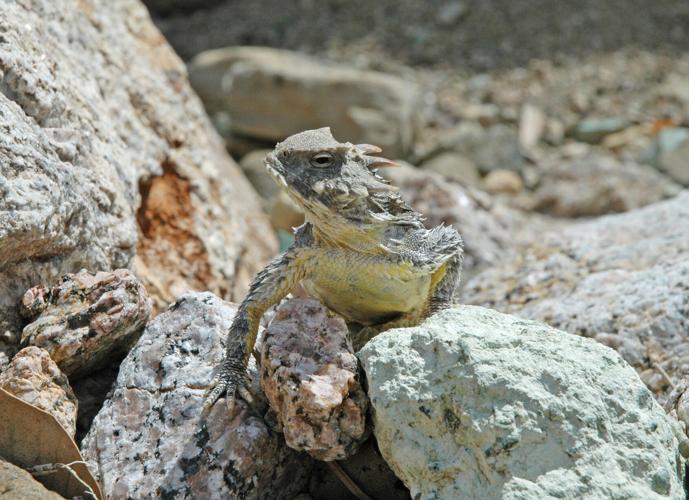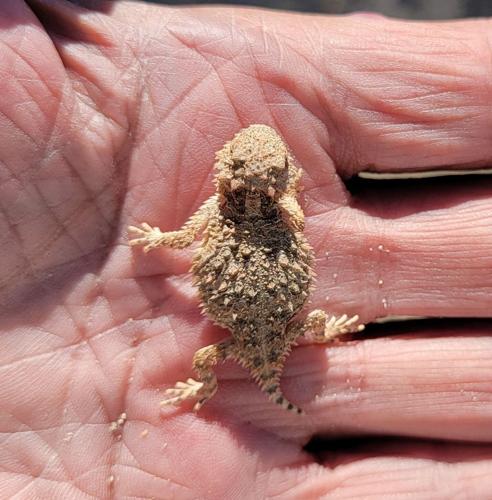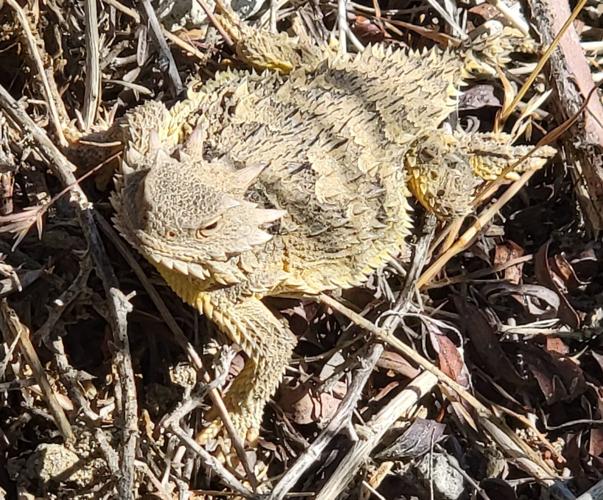If there was a popularity contest for the reptile world, it’s pretty obvious that no snakes would be on the winners’ podiums — ophidiophobia, the irrational fear of snakes, is too widespread for that. But most people are more welcoming toward lizards, and among the most beloved lizards of all are the horned lizards.
The Tehachapi Mountains are home to a species of horned lizard that can usually be found in fairly open grassy areas with sandy washes, gravel beds or patches of decomposed granite, or rarely used dirt roads.
Horned lizards, colloquially referred to as “horny toads,” get their name from the crown of horns on their head, which can help protect them from predators — by making it difficult for snakes to swallow them, for example.
Horned lizards are quite flat and their bodies are often oval or pumpkin-seed shaped, like a bluegill fish of the land. They have enlarged, pointed scales on their backs and tail that contribute to their spiny appearance and cryptic markings.
The species of horned lizard found in the Tehachapi Mountains is currently known as Blainville’s Horned Lizard (Phrynosoma blainvillii). I say “currently” because I am in hopes that eventually that name will get changed to something more descriptive and appropriate.
It was named for Henri de Blainville, a French zoologist and taxonomist who was born in 1777 and died in 1850. He was quite influential and he coined the term “paleontology” in 1822, though he rejected the evidence of evolution.
It is unlikely that de Blainville ever set foot anywhere near a living horned lizard, and he was probably never even in California. The lizard was named in de Blainville’s honor in 1839 by a younger British zoologist named John Edward Gray, who was working at the British Museum in London to catalogue the reptile collection of dead specimens that had arrived by sailing ship from far afield.
I have no objection to de Blainville’s name being used for the herpetological scientific name of this lizard, blainvillii, but it seems silly to use it for the common name when the man had no connection whatsoever to the actual lizard. While it was a frequent practice of pioneering biologists, primarily in the 1800s, to name newly “discovered” species after their elite colleagues or patrons, I think it’s regrettable for animals and plants to still be stuck with these obscure relics as their common names.
In any case, our local horned lizard is popular with nearly everyone who spots one of these charming little reptiles, which look like some kind of miniature dinosaur. Phrynosoma blainvillii, which in some sources may be referred to as the San Diego Horned Lizard, reaches up to five inches long, from their snout to the tip of their stubby tail, with females growing slightly larger than males.
Horned lizards throughout the United States, including the Texas Horned Lizard, have experienced population declines in the past 50 years. This is largely due to habitat loss or degradation, exotic species introductions, and the decline in their preferred food: ants.
And not just any ants — horned lizards prefer to eat ants in the Pogonomyrmex genus. In our area, these are the familiar Red Harvester Ants, which are medium-sized ants with a painful bite. These ants feed primarily on grass seeds, which is why horned lizards are seldom found too far from good supplies of grass seed. The grass itself doesn’t have to be lush or thick, and Red Harvester Ants also gather seeds from Red-stemmed Filaree and other plants, but the ants do show a preference for grass seeds.
One of the most endearing things about horned lizards are their babies, which look like tiny versions of their parents. These little quarter-sized hatchlings are adorable, as well as vulnerable — few manage to survive their many predators to reach adulthood.
Horned lizards’ main defense is their camouflage, which helps hide them from would-be predators. Horned lizards usually either remain motionless, or sprint as fast as they can for the cover of a bush or rocks when threatened.
Horned lizards can also squirt blood from the corner of their eyes when alarmed, though this is uncommon and often triggered by the presence of a dog, which suggests that it evolved as a defense against canine predators like foxes and coyotes.
The Nuwä (Kawaiisu or Southern Paiute) word for horned lizard is makütsaze, pronounced mah-kuht-SAH-zeh, and they were considered powerful for their size, since they are able to eat Red Harvester Ants without ill effect.
Horned lizards are less common than they once were, unfortunately, but they still persist in the Tehachapi Mountains and remain one of the most well-liked reptiles in our area.
Have a good week.
Jon Hammond has written for Tehachapi News for more than 40 years. Send email to tehachapimtnlover@gmail.com.









Commented
Sorry, there are no recent results for popular commented articles.